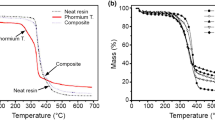Abstract
An investigation was carried out to explore the morphology and mechanical properties of diglycidyl ether of bisphenol A epoxy resin (DGEBA) with liquid natural rubber possessing hydroxyl functionality (HLNR). Though modification of epoxies by synthetic rubber has been extensively studied not much attention has been paid to liquid natural rubber. Photo depolymerisation of natural rubber enables us to synthesise low molecular weight oligomers by varying the experimental parameters. Epoxy resin was cured using nadic methyl anhydride as hardener in presence of N,N-dimethyl benzyl amine accelerator. Hydroxylated natural rubber of different concentrations is used as modifier for epoxy resin. The addition of such chemically modified liquid rubber to an anhydride hardener–epoxy resin mixture has given rise to the formation of a two-phase microstructure in the cured systems, consisting of spherical particles of liquid natural rubber strongly bonded to the surrounding matrix, there by providing the required mechanism for toughness enhancement. Subinclusions of epoxy resin were present in the elastomer domains as secondary particles (particle in particle morphology) as evidenced from the SEM (scanning electron micrograph) photomicrographs. The origin of the so-called secondary phase separation is due to the combined effect of hydrodynamics, viscoelastic effects of rubber phase, diffusion, surface tension, polymerisation reaction and phase separation. In a dynamic asymmetric system, the diffusion of the fast dynamic phase is prevented by the slow dynamic phase, and hence the growth of fast dynamic phase gets retarded due to the slow dynamic phase. In the case of low viscosity blends the growth of fast dynamic phase turns fast and hence diffusion of fast dynamic phase cannot follow geometrical growth and cannot establish local concentration equilibrium and hence double phase separation takes place. The double phase separation is responsible for the enhanced impact and toughness behaviour of the blends. The mechanical behaviour of the liquid rubber-modified epoxy resin was evaluated in terms of tensile and flexural properties.







Similar content being viewed by others
References
Potter WG (1970) Epoxide resins. Springer, New York
Mark HF, Bikales N, Overberger CG, Menges G, Kroschwitz JI (1986) Encyclopedia of polymer science and engineering, vol 6. Emulsion Polymerization to Fibers, Manufacture, 2nd edn. ISBN: 978-0-471-80050-7
Brydson JA (1982) Plastic materials, chap 27, 4th edn. Butterworth Scientific, London
Young RJ, Beaumont PWR (1977) J Mater Sci 12:684. doi:10.1007/BF00548158
Moloney AC, Kausch HH, Stieger (1983) J Mater Sci 18:208. doi:10.1007/BF00543827
Spanoudakis J, Young RJ (1984) J Mater Sci 19:473. doi:10.1007/BF02403234
Pearson RA, Yee AF (1993) Polymer 34:3658
Mc Garry FJ, Willner AM (1968) Research report R 68-6, School of Eng., Massachusetta Institute of Technology
Garry FJMC, Sultan JN (1973) Polym Eng Sci 13:29
Bucknall CB, Franco M, Mondragon I (1999) J Appl Polym Sci 72:427
Franco M, Corcuera MA, Gavalda J, Vaka A, Mondragon I (1997) J Appl Polym Sci Part B Polym Phys 35:233
Bucknal CB, Patreidge IK (1986) Polym Eng Sci 26:54
Verchere D, Sautereau H, Pascault JP, Moschiar SM, Riccardi CC, Williams RJJ (1989) Polymer 30:107
Ratna D, Banthia AK, Deb PC (2000) J Appl Polym Sci 78:717
Bascom WD, Cottington RL, Jones RL, Peyser P (1975) J Appl Polym Sci 19:2425
Manzione LT, Gillham JK, Mc Pherson CA (1981) J Appl Polym Sci 26:884
Latha PB, Adhinarayanan K, Ramaswamy R (1994) Int J Adhes Adhes 14:57
Sheng X, Lee JK, Kessler MR (2009) Polymer 50(5):1264
Deng S, Zhang J, Ye L, Wu J (2008) Polymer 49(23):5119
Sham ML, Kim JK (2005) J Appl Polym Sci 96(1):175
Ruiz-Pérez L, Royston GJ, Fairclough J, Anthony Ryan AJ (2008) Polymer 49(21):4475
Francis B, Rao VL, Poel GV, Posada F, Groeninckx G, Ramaswamy R, Thomas S (2006) Polymer 47(15):5411
Nanda Kumar SA, Denchev Z (2009) Prog Org Coat 66(1):1
Tanaka H, Araki T (1998) Phys Rev Lett 81:389
Tanaka H (1992) Macromolecules 25:6377
Tanaka H (1995) J Chem Phys 103:2361
Tanaka H (1996) J Chem Phys 105:10099
HUO Y, Jiang X, Zhang H, Yang Y (2003) Chem Phys 118:9830
Ravindran T, Gopinathan Nair MR, Joseph Francis D (1988) J Appl Polym Sci 35:1227
Ratna D, Banthia AK (2000) Polym Int 49:281
Ratna D, Banthia AK, Deb PC (2001) J Appl Polym Sci 80:1792
Rajalingam P, Radhakrishnan G, Francis JD (1991) J Appl Polym Sci 43(7):1385
Nirmal SN, Maithi C, Padmavathi T, Vanaja A, Rao RMVGK (2006) High Perform Polym 18:57
Demerdash GAAG, Sayed Ahmed WAA (2007) High Perform Polym 19:439
Ijima T, Yoshika N, Tomoi M (1992) Eur Polym J 28:573
Willam RJJ, Borrajo J, Adabbo HE, Rojas AJ (1984) Rubber-modified thermoset resins. Adv Chem Ser 208, chap 13. ACS, Washington, DC, pp 195–213
Riew CK (1989) Rubber toughened plastics. Adv Chem Ser 222. ACS, Washington, DC
Kinloch AJ, Young RJ (1983) Fracture behaviour of polymers. Applied Science Publishers Ltd, London, New York. ISBN: 0-85334-186-9
Bagheri R, Pearson RA (1996) J Mater Sci 31:3945. doi:10.1007/BF00352655
Author information
Authors and Affiliations
Corresponding author
Rights and permissions
About this article
Cite this article
Mathew, V.S., Sinturel, C., George, S.C. et al. Epoxy resin/liquid natural rubber system: secondary phase separation and its impact on mechanical properties. J Mater Sci 45, 1769–1781 (2010). https://doi.org/10.1007/s10853-009-4154-8
Received:
Accepted:
Published:
Issue Date:
DOI: https://doi.org/10.1007/s10853-009-4154-8




